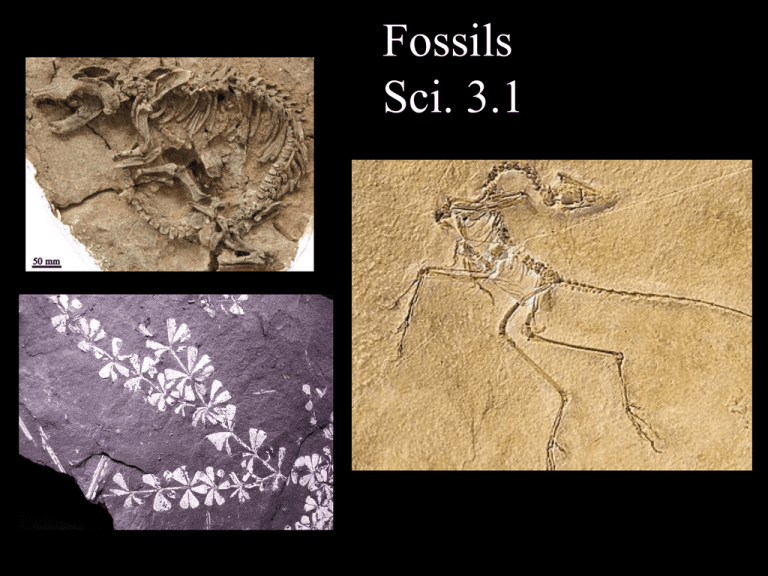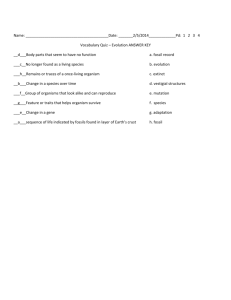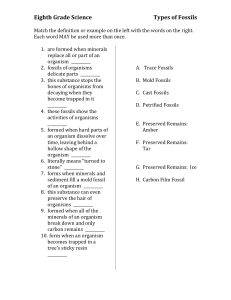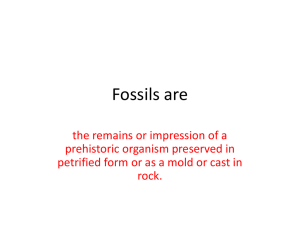Fossils 3.1
advertisement

Fossils Sci. 3.1 Fossil: • Preserved remains or traces of living things • Only in sedimentary rock • Can tell how, when, and where a thing lived Question 1 1a. What kind of rocks are fossils found in? igneous, metamorphic, sedimentary, all of the above 1b. Fossils can tell what about a living thing? Where it lived, how it lived, when it lived, all of the above Conditions must be just right • Usually a quick burial in sediments • Protected from scavengers, microorganisms, etc… Question 2 2a. It is not very likely that an individual organism will become a fossil. T/F 2b. If an organism is not quickly buried in sediments: scavengers can tear it up, waves can destroy it, microorganisms can cause it to decay, all of the above Hard parts • More likely to be fossilized Question 3 3a. Which part of an octopus would most likely become a fossil? Tentacles, beak, head, all of the above 3b. Which type of animal would you be more likely to find fossils of? Snails with shells, slugs without shells, worms, leeches Permineralized remains • Minerals replace original (partially or completely) Question 4 4a. In some permineralized fossils, none of the original material that made the organism is left. T/F 4b. In some permineralized fossils, some of the original material that made the organism is encased. T/F Carbon films • Left over C forms a silhouette Question 5 5a. A carbon film fossil is a three dimensional version of the original organism. T/F 5b. Carbon film fossils often show details of the soft parts of an organism. T/F Coal • C from prehistoric plants Question 6 6a. Coal is mainly what’s left over from prehistoric plants. T/F 6b. Coal formation takes a great deal of: time, pressure, heat, all of the above Mold • Cavity left after organism has decayed Cast • A copy of original made of sediments or minerals Question 7 7a. A cup cake pan is a: mold, cast 7b. A cup cake is a: mold, cast Original remains • Extremely rare • Ex: amber, ice, tar Question 8 8a. The most common type of fossils are original remains. T/F 8b. In which situation could original remains be preserved for thousands to millions of years? An organism is: encased in tree sap, frozen in ice, tar, all of the above Trace fossils • Footprints, trails, burrows Question 9 9a. Trace fossils can include actual remains. T/F 9b. Which kind of fossil is the preserved evidence of past activity? Permineralized, carbon film, mold/cast, trace Index fossils • Common species that existed for a short time Question 10 10a. A good index fossil is of an organism that was: common/abundant, rare, not widely distributed 10b. A good index fossil is of an organism that: existed for a long time, existed briefly, lived in only specific places Fossils describe ancient environments Question 11 11a. What type of terrain was here 310 million years ago (when we were below the equator)? Swamps, deserts, deep seas, shallow seas 11b. Was this area above or below the equator 310Ma (Mega-annum)? Above, below






